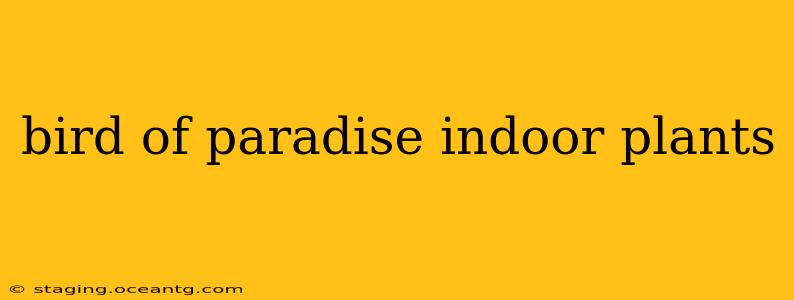The Bird of Paradise plant, with its striking, exotic blooms, is a coveted addition to many homes. But successfully cultivating this beauty indoors requires understanding its specific needs. This comprehensive guide will explore everything you need to know about caring for your Bird of Paradise plant indoors, answering common questions and offering expert tips for thriving growth.
What are the different types of Bird of Paradise plants suitable for indoor growing?
While several Bird of Paradise species exist, Strelitzia reginae is the most common and readily available variety for indoor cultivation. This species is prized for its vibrant orange and blue flowers resembling a crane's head. Other species, like Strelitzia nicolai (Giant White Bird of Paradise), are larger and less suitable for indoor environments unless you have a very spacious room and high ceilings. Focus on Strelitzia reginae for the best indoor success.
How much sunlight does a Bird of Paradise need indoors?
Bird of Paradise plants thrive in bright, indirect sunlight. Direct sunlight can scorch their leaves. An east- or west-facing window is ideal, providing ample light without harsh midday sun. In northern climates, or during winter months, you might consider supplementing with a grow light to ensure the plant receives sufficient light for optimal growth and flowering. A deficiency in light can result in poor growth and a lack of blooms.
How often should I water my indoor Bird of Paradise plant?
Overwatering is a common problem for indoor Bird of Paradise plants. Allow the top inch or two of soil to dry out completely before watering again thoroughly. During winter months, when the plant's growth slows, reduce watering frequency. Always ensure the pot has adequate drainage to prevent waterlogging, which can lead to root rot. Use well-draining potting mix specifically designed for indoor plants.
What type of soil is best for indoor Bird of Paradise plants?
Well-draining potting mix is essential. A blend of peat moss, perlite, and coco coir is an excellent choice, providing aeration and preventing compacted soil. Avoid heavy clay-based soils that retain too much moisture. The soil should retain some moisture but not be soggy.
How often should I fertilize my indoor Bird of Paradise plant?
Fertilize your Bird of Paradise during the growing season (spring and summer) with a balanced liquid fertilizer diluted to half strength. Apply every 2-4 weeks. Reduce or cease fertilization during the fall and winter months when growth slows down. Over-fertilizing can damage the plant's roots.
How do I repot my Bird of Paradise plant?
Repotting is usually necessary every 2-3 years, or when the plant becomes root-bound (roots circling the pot). Choose a slightly larger pot with drainage holes. Carefully remove the plant from its current pot, gently loosen the roots, and place it in the new pot with fresh potting mix.
How can I get my Bird of Paradise plant to flower indoors?
Flowering can be challenging indoors. Consistent bright, indirect light, appropriate watering, and fertilization are key. Ensure your plant is not pot-bound and has adequate space to grow. Mature plants are more likely to flower; be patient, as it may take several years for a young plant to bloom. Maintaining consistent temperature and humidity levels can also contribute to flowering.
What are common pests and diseases that affect indoor Bird of Paradise plants?
Mealybugs, spider mites, and scale insects are common pests. Regularly inspect your plant for signs of infestation. Treat infestations promptly with insecticidal soap or neem oil. Overwatering can lead to root rot, a fungal disease. Ensure good drainage and avoid overwatering to prevent this problem.
Conclusion:
With proper care and attention, your Bird of Paradise plant can thrive indoors, bringing a touch of tropical beauty to your home. Remember consistent light, proper watering, and appropriate fertilization are the keys to success. Enjoy the vibrant blooms and the stunning foliage of this captivating plant!
